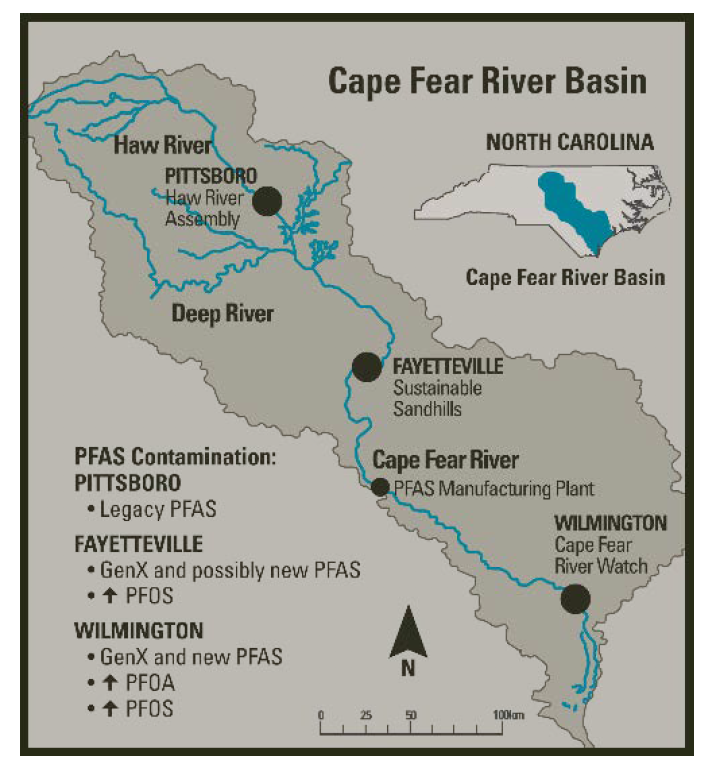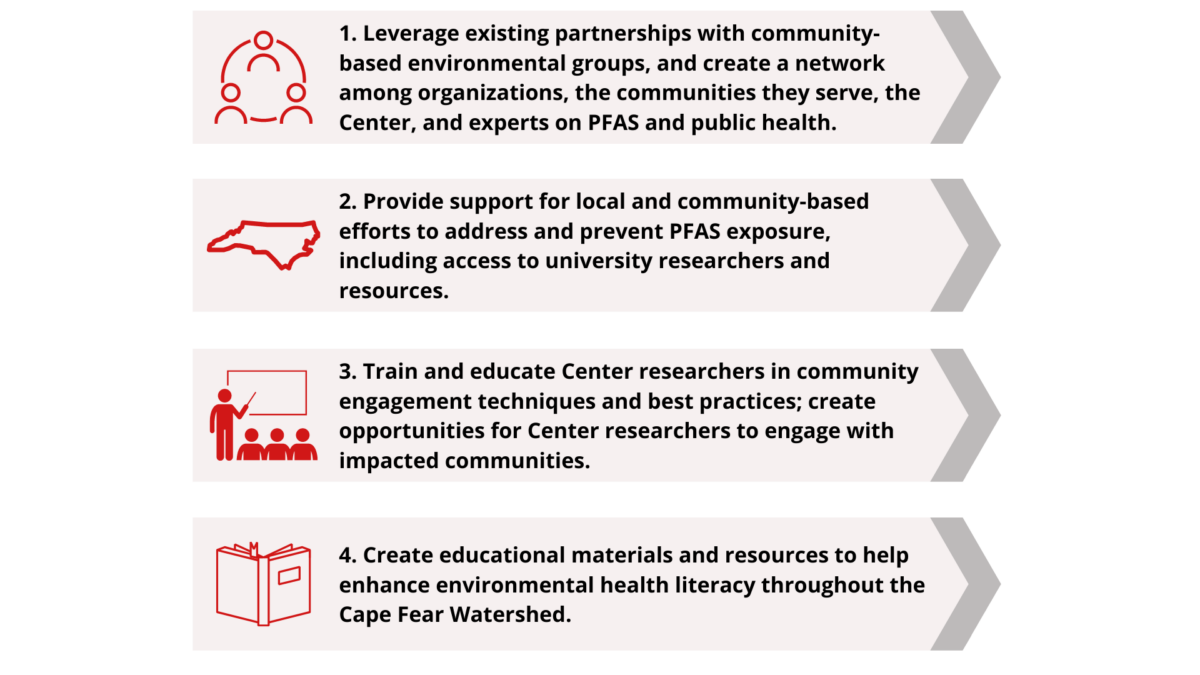Community Engagement Core (CEC)
Director: Katlyn May
Community Engagement Specialist: Lacey Brown

basin, showing CEC community partners and PFAS sources.
Per- and polyfluoroalkyl substances (PFAS) are chemicals that pose a unique challenge for environmental and human health. A broad class of over 3,000 chemicals designed to be water- and stain-resistant, PFAS were used for decades in a range of products and industries. While low concentrations of PFAS are present around the world because of their widespread use, point sources (single, identifiable sources of pollution) can cause elevated PFAS levels in specific communities.
One such community is the Cape Fear River Basin in North Carolina.
The Cape Fear River basin is the largest river basin in North Carolina. It provides drinking water for more than 1.5 million people and has been impacted by PFAS contamination from many sources for decades.
Only a handful of PFAS have been closely studied by researchers, but we already know that a few of the major PFAS (namely PFOS and PFOA) are proven to cause various health effects including cancer, high cholesterol, and low birth weights. Currently, no mandatory regulatory standard exists for PFAS in North Carolina, which means water treatment facilities are not required to remove PFAS from drinking water.
The sheer number of chemicals that are classified as PFAS, as well as the lack of toxicological and human health information and regulatory standards, make PFAS contamination a difficult issue for many communities to address.
The mission of the Community Engagement Core (CEC) is to empower Cape Fear River communities impacted by PFAS contamination to build knowledge and develop strategies to address and reduce PFAS exposure and related environmental health concerns. To achieve our mission, we have four goals:

Communicating environmental health topics requires the use of some specific terms. Below we’ve defined a few:

Environmental Health Literacy: The degree to which people and communities understand how the environment can impact their health, and then take action to reduce harmful environmental exposures.
A group of community members who understand that they have been exposed to lead from car exhaust from nearby freeways, get their soil tested, and then inform their neighbors and advocate for clean soil are demonstrating environmental health literacy.

Multidirectional Communication: An exchange of information and ideas between multiple partners, not just university scientists presenting their research and leaving.
Community members share concerns about potential chemical exposures in drinking water, researchers listen and perhaps share results from their work studying chemicals in drinking water. University scientists and all kinds of stakeholders remaining in ongoing communication, where all parties listen to and learn from each other’s expertise demonstrates multidirectional communication

Social Connectivity: The level of closeness or connectedness within a community.
Communities that can share information with friends, neighbors, and residents quickly and effectively usually have strong social connectivity. They might have active social media pages, hold events at community centers, have nonprofits that collaborate with each other, a strong network of faith-based groups, among others.

Environmental Justice: The fair treatment and meaningful involvement of all people regardless of race, color, national origin, or income, with respect to the development, implementation, and enforcement of environmental laws, regulations, and policies.
We often see issues of environmental justice when harmful environmental exposures, like hazardous waste sites or chemical plants, are disproportionately located in majority Black or brown communities. With PFAS exposures, most residents have to pay for their own in-home water filtration systems, which means that people with less disposable income will have disproportionately less access to at-home treatment, an example of an environmental injustice.
Community Partners
The CEC works closely with three local community organizations who are working to address PFAS in drinking water.

Haw River Assembly: The Haw River Assembly is our Center’s Upper Cape Fear River Basin community partner located in Pittsboro, NC. The Haw River Assembly was founded in 1982 and is dedicated to the restoration and protection of the Haw River and Jordan Lake at the headwaters of the Cape Fear River Basin.

Sustainable Sandhills: Sustainable Sandhills is our Center’s Middle Cape Fear River Basin community partner located in Fayetteville, NC. Since 2005, Sustainable Sandhills has been devoted to sustainability and conservation efforts for communities near the Fort Bragg military post (the world’s largest military installation).

Cape Fear River Watch (CFRW): CFRW is our Center’s Lower Cape Fear River Basin community partner located in Wilmington, NC. Founded in 1993, CFRW is dedicated to the improvement and preservation of the Cape Fear River Basin. The CFRW has championed information dissemination, advocacy, and legal action related to the PFAS contamination in the Cape Fear River from DuPont/Chemours.
CEC Members
Katy May, CEC Director
kmay2@ncsu.edu | 919-515-2681

Ms. May is trained in community-based environmental management, program evaluation, and science education. She is currently completing a doctoral degree in STEM education, focused on informal learning and public education. Katy oversees the day-to-day aspects of the CEC, the Center’s engagement with community partners and other stakeholders, and training for researchers and graduate students in community engagement.
Lacey Brown, CEC Community Engagement Specialist
lrbrown4@ncsu.edu

Ms. Brown is the Community Engagement Specialist for both Superfund and CHHE. As a North Carolina native, Lacey has forged connections with folks across the state and seen firsthand how environmental pollution can upend lives. After moving to Wilmington in 2021, she became aware of PFAS and their associated risks to human health and the environment. Since then, she has been an active member of the grassroots effort to reduce and eliminate PFAS contamination in the area.
Lacey is a member of Clean Cape Fear’s Leadership Team.
Lacey holds a double B.S. in Communication Studies and Public Relations. She is currently pursuing an M.S. via NC State’s Climate Change and Society program, studying climate change communication and environmental policy.
